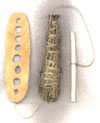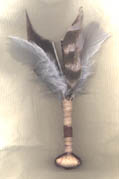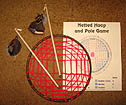
Waaban Aki Crafting ~ Games, Toys & Puzzles

 |
Ga1 Ga2 Ga3 Ga4 Ga5 | Peg Board Games in a Native American Tradition Five separate unique games including Playing Leader, Jump the Creek, Serpent and Stones, Hunting Animals and The Square Game. On sturdy felt-backed wooden boards (7" x 5"), all games have hand made pegs and playing pieces, and come with Native American History and Playing Instructions. Click Here for More Information on these Peg Games. | Not Available at this time. |
 |
To1 | Birchbark Triangle and Ball Game My own unique design which I based on the description of a traditional toy used by Penobscot children, this game consisted of a stiff piece of birch bark cut into a triangular shape, with a hole in the center. To one corner of the bark triangle is attached a string, and a ball is attached to the other end of the string. The circular hole in the center of the bark triangle is made only slightly larger than the ball attached to the string. The object of the game is to get the ball to drop through the hole. Measures approximately 6" wide. (I've found many other people copying my design!) | Not Available at this time. |
 |
To2 | Cedar Bundle & Pin Game One Native American use for cedar twigs is the 'bundle and pin' game. This traditional Woodland Indian game is based on a game called "T'wis" by the Passamaquoddy Natives of Maine. The T'wis is an indoor game that is composed of an oblong piece of moose hide, about four inches in length, punctured with small holes, the center one being slightly larger than the others. This piece of hide is joined to a bundle of cedar (arbor vitae) twigs, tightly wound round with the cord. To this by several inches of string is attached a sharp pointed stick, tied near the center and held between the thumb and forefinger like a pen. The game consists of giving the moose hide an upward toss and at the same time piercing one of the holes with the pointed end of the stick. Bundle measures approximately 6" long. | Not Available at this time. |

| To3 | Moose Antler Buzzer The buzzer is an amusement, and a game of skill, for Native American children across North America. Usually made of a flat piece of wood, pottery, gourd or bone. A buzzer ranges in diameter from one to four inches, with a deerskin thong or twined sinew strand 20 inches long doubled over and threaded through the two holes in the disk to be twirled. Many Native buzzers are made from bone knuckles or knee bones. Flat buzzers of wood are often engraved or painted with designs, which create new patterns seen when the toy spins. When properly spinning, the buzzers make a sound similar to the sound of the wind sighing. Antler disk measures 1 1/2", game is approximately 8" in length when extended. | Not Available at this time. |
 |
To4 | Cornhusk & Feather Shuttlecock A game of shuttlecock, sometimes played with a wooden battledoor, is common among the tribes on the Northwest coast. The Zuni play with shuttlecocks made of corn husks, stuck with feathers, batted with the hand, and a similar object was found in a cliff-dwelling in the Canyon de Chelly. The game is played as frequently by the younger boys as by their elders, and always for stakes. One bets that he can toss the shuttlecock a given number of times. While ten is the number specially associated with the game. The wagers are often made for twenty, fifty, and sometimes a hundred throws. Measures approximately 5"-6" in length. | Not Available at this time. |
 |
To5 | Antler Dice Game in Pouch Here are the Penobscot rules and instructions for this widespread Native American Game. The dice game has innumerable variations across North America. This traditional Native American game is called Hubbub by the Narragansett in southern New England. The game described in the 1600's includes five or six small dice which are tossed in a wooden bowl or basket. The game is accompanied by sticks or beans for scoring. Dice are usually carved from bone or antler, in some versions plum or peach pits are used. Dice are engraved, burned or painted to distinguish one side from the other when they are tossed. Pouch measures approximately 5" without fringe. | Not Available at this time. |
 |
To6 | Netted Hoop & Pole Game Nearly all Native American groups of North America have a game they play with a hoop and a pole. Natives of different groups have their own special ways to play the Hoop & Pole Game, but in all the games a person tosses a dart of some kind at a circular hoop. People of the Grosventre use a net of buckskin lacing. The holes of the web vary in shape and each has it's own name and value. The large square in the center is the heart; the rectangles coming out in four directions are the buffalo bulls; the last rectangle at the edges of the hoop are the buffalo cows; the four groups of small triangles in between the rectangles are the buffalo calves; the large pentagonal holes along the edge of the ring are the wolves, and the small holes at the edge of the ring (on either side of the rectangles called cows) are the coyotes. Hoop measures approximately 10" in diameter. Poles measure 11" long. | Not Available at this time. |
 |
To7 | Cornhusk Wheel & Corncob Dart Game This ingenious game uses a cornhusk game ring and darts made from corncobs, sticks and feathers. Cornhusk wheel and dart games have traditionally been made by the Hopi of Arizona and the Zuni of New Mexico. The corncob is first pierced with a pointed stick a few inches long from one end of the cob. Into the other end of the cob, two wing feathers are inserted into the whole. When this dart is tossed the feathers pull on the air cause the dart to spin like a pinwheel! Wheels measure approximately 9". Darts measure approximately 12"-13" in length. | Not Available at this time. |
 |
Bo3 | Bone Whistle These whistles (measuring 3-5" long) are like those archaeologists have found dating back at least 5000 years in northeastern North America. Such perforated long bones may have been musical instruments or hunting calls. The whistles and flutes are usually made of the wing and leg bones of large birds, especially that of the turkey, while some are produced from the long bones of mammals like that of the deer. These whistles are made from turkey bones, and are intended for amusement purposes only. | Not Available at this time. |

| To8 | Elk Toe Bones Ring & Pin Game
The ring and pin game has ancient Native American roots. Nearly every tribe across North America has its particular version which uses unique materials from the natural environment for the ring and pin. In all varieties of this game, a ring or other target is fastened to a cord. The target is thrown into the air and must be speared by the pin attached to the other end of the cord. Simple targets are carved rings of bone or hide, strings of toe bones or fish vertebra, perforated holed skulls, dried squash rinds, or bundles of twigs or hair. The pins are carved from wood, long bones or antler in prehistoric times, while metal pins sometimes used after contact with Europeans. A leather or fur counterweight is sometimes attached to the target. The game is often played for women's and children's amusement, and for stakes. Players usually number two. Each party gets two tries to impale the ring the greatest number of times, after which it must be passed to the next player. Wooden pins measure approximately 6" long. | Not Available at this time. |
My games, toys, dolls and figures are not intended for children under 3 years of age.
As my products contain small parts and natural materials, adult supervision is recommended for
young children.
|
E-mail Address:
Mailing Address: P.O. Box 422 Vernon, CT 06066
© 1997-
Waaban Aki Crafting |
Not Currently Accepting New Orders 
Home Page |